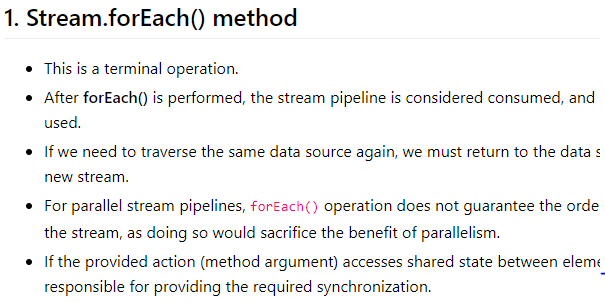Java Stream forEach() method is used to iterate over all the elements of the given Stream and to perform an Consumer action on each element of the Stream.
The forEach() is a more concise way to write the for-each loop statements.
1. Stream forEach() Method
1.1. Method Syntax
The forEach() method syntax is as follows:
void forEach(Consumer<? super T> action)Consumer is a functional interface and action represents a non-interfering action to be performed on each element in the Stream. It accepts an input and returns no result.
1.2. Description
- The
forEach()method is a terminal operation. It means that it does not return an output of typeStream. - After forEach() is performed, the stream pipeline is considered consumed, and Stream can no longer be used.
- If we need to traverse the same data source again (the collection backing the Stream), we must return to the data source to get a new stream.
- For parallel streams, the
forEach()operation does not guarantee the order of elements in the stream, as doing so would sacrifice the benefit of parallelism. - If the provided Consumer
actionaccesses the shared state between the Stream elements theactionis responsible for providing the required synchronization.
2. Stream forEach() Examples
Example 1: Traversing the elements of a Stream and printing them
In this Java example, we are iterating over a Stream of Integers and printing all the integers to the standard output.
List<Integer> list = Arrays.asList(2, 4, 6, 8, 10);
Consumer<Integer> action = System.out::println;
list.stream()
.forEach( action );Note that we can write the above iteration using the enhanced for-loop as well.
for (Integer i : list) {
System.out.println(i);
}Example 2: Traversing the elements in reverse order and printing them
Java example to iterate over stream elements and print them in reverse order.
List<Integer> list = Arrays.asList(2, 4, 6, 8, 10);
list.stream()
.sorted(Comparator.reverseOrder())
.forEach(System.out::println);Program output.
10
8
6
4
23. Conclusion
In this tutorial, we learned to use the forEach() method to iterate through all the elements of a Stream.
Though we can use the enhanced for-each loop for the iteration, the primary difference between the forEach() method and for-each loop is that the for-each loop is an external iterator, whereas the new forEach() method is an internal iterator.
Drop me your questions related to Stream forEach() method in Java Stream API.
Happy Learning !!


Comments